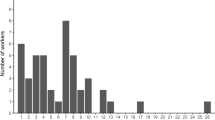Summary
Lasius pallitarsis (Provancher) ant colonies were offerred a choice between two food patches of equal nutritive quality but with one of the patches having associated with it one of several types of mortality risk indicators. Foraging decisions appeared to be affected only when theL. pallitarsis foragers could actually physically encounter a potential mortality agent (a largerFormica subnuda Emery). Odors of either crushed conspecifics, aF. subnuda, or aF. subnuda in conflict withL. pallitarsis workers, were sensed byL. pallitarsis workers but did not affect patch choice.
Resume
On a offert à des colonies de fourmisLasius pallitarsis (Provancher) le choix entre deux sources de nourriture d'égale valeur nutritive mais différant quant au risque perçu de mortalité, une des sources étant associée avec plusieurs indices de risque de mortalité. Les décisions relatives à la recherche de nourriture ne semblent être affectées que quand les ouvrièresL. pallitarsis entrent en contact physique avec un risque concret de mortalité (une groseFormica subnuda Emery, en l'occurence). Les ouvrières deL. pallitarsis perçoivent les odeurs de conspécifiques broyées, deF. subnuda ou deF. subnuda en combat avec d'autres ouvrières deL. pallitarsis, mais leur choix de source de nourriture n'en est pas affecté.
Similar content being viewed by others
References
Attygalle A.B., Morgan E.D. 1985. — Ant trail pheromones.Adv. Insect Physiol., 18, 1–30.
Brian M.V., 1983. —Social Insects: Ecology and Behavioural Biology. Chapman and Hall. London.
Czechowski W., 1975. — Wyprawy rabunkoweFormica (Raptiformica) sanguinea Latr. (Hymenoptera, Formicidae).Przegl. Zool., 19, 33–43. [Cited in Le Moli F. and A. Mori, 1987. The problem of enslaved ant species: Origin and behavior. In, From Individual to Collective Behavior in Social Insects. Ed. J.M. Pasteels and J.-L. Deneubourg. Birkhäuser Verlag, Basel, pp. 333–363].
Ettershank G., 1967. — A completely synthetic diet for ants (Hym. Formicidae).Entomol. Month. Mag., 103, 66–67.
Gentry J.B., 1974. — Response to predation by colonies of the Florida harvester ant,Pogonomyrmex badius.Ecology, 55, 1328–1338.
MacKay W.P., 1982. — The effect of predation of western widow spiders (Araneas: Theridiidae) on harvester ants (Hymenoptera: Formicidae).Oecologia, 53, 406–411.
Möglich M., Hölldobler B., 1975. — Communication and orientation during foraging in the antFormica fusca.J. Comp. Physiol., 101, 275–288.
Nonacs P., 1988. — Foraging, mortality risk and colony growth in ants. Ph. D.Thesis, Simon Fraser University, Burnaby, BC.
Parry K., Morgan E.D., 1979. — Pheromones of ants: a review.Physiol. Entomol., 4, 161–189.
Sokal R.R., Rohlf F.J., 1981. —Biometry, 2nd ed. W.H. Freeman, San Francisco, CA.
Traniello J.F.A., 1983. — Social organization and foraging success inLasius neoniger (Hymenoptera: Formicidae): behavioral and ecological aspects of recruitment communication.Oecologia, 59, 94–100.
Van Vorhis Key S.E., Baker T.C., 1986. — Observation on the trail deposition and recruitment behaviors of the Argentine ant,Iridomyrmex humilis (Hymenoptera: Formicidae).Ann. Entomol. Soc. Am., 79, 283–286.
Whitford W.G., Bryant M., 1979. — Behavior of a predator and its prey: the horned lizard (Phrynosoma cornutum) and harvester ants (Pogonomyrmex spp.).Ecology, 60, 686–694.
Author information
Authors and Affiliations
Rights and permissions
About this article
Cite this article
Nonacs, P., Dill, L.M. Foraging response of the antLasius pallitarsis to food sources with associated mortality risk. Ins. Soc 35, 293–303 (1988). https://doi.org/10.1007/BF02224061
Received:
Accepted:
Issue Date:
DOI: https://doi.org/10.1007/BF02224061




